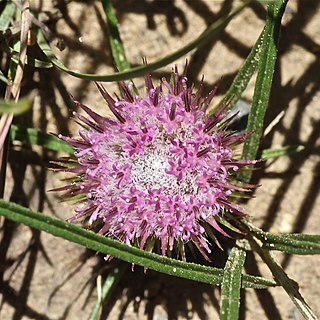Araneose. Leaves discolorous, sessile, linear-elliptic, sometimes linear and wide, or narrowly elliptic, base broadly cuneate, apex acute, gland-pitted and glabrous on upper surface or evanescent finely araneose, densely greyish araneose-lanate beneath. Capitula solitary and terminal on stem and branches; involucres broadly obconic-campanulate, truncate-concave at base; involucral bracts narrow, often squarrose. Florets yellowish to purplish or white, linear. Flowering time Feb., Mar.? Pappus of many barbellate bristles. Cypselae compressed-turbinate, obscurely 10-ribbed, densely strigose-hispid, glandular-viscid.
Leaves discolorous, subsessile or with the midrib petiole-like in the lower c. 10 mm.; mostly 25–110 x c. 6 mm. and linear-elliptic, sometimes linear and c. 2 mm. wide, or 20–60 x 6–15 mm. and narrowly elliptic; acute at the apex, tapering into a narrowly winged midrib or broadly cuneate at the base, sharply callose-tipped serrulate, gland-pitted and glabrous on the upper surface or evanescent finely araneose, densely greyish araneose-lanate beneath, midrib prominent and puberulous beneath or glabrescent, often with 2 distinct lateral veins from the base.
Phyllaries 90–200 in many series, increasing from c. 2 mm. long outside to c. 30 mm. long inside, exceeding the pappus, narrowly triangular-subulate or stiffly subulate, straight, or outer ones ± curved, minutely sharply serrulate on the margins, lamina with narrow dark-green or purplish grooves on either side of a broad midrib, finely araneose-lanate or glabrescent.
Prostrate perennial herb. Leaves linear-elliptic to narrowly elliptic, margin entire to serrulate, lower surface white-felted. Heads homogamous, discoid, 15-30 mm long, broadly campanulate, solitary or subcorymbosely arranged at branch tips. Inner involucral bracts with subulate apices, exceeding pappus. Pappus setae barbellate. Flowers purple or whitish.
A spreading herb. It lies along the ground. The aerial stems arise from woody underground stems. The aerial stems are 5-60 cm long. And the underground stems with tubers are 2-18 cm long. The leaves are 3-11 cm long and 6 mm wide. They are long and narrow. The flower heads are like thistles. There are 20-90 purple-mauve florets. This plant varies a lot.
Achenes to c. 2 mm. long, ± compressed-turbinate, obscurely c. 10-ribbed, densely strigose-hispid, glandular-viscid; pappus copious, many-seriate, setae 7–12 mm. long, finely barbellate, the outer slender, the innermost very narrowly scarious-winged in the lower part.
Stems annual, few to many, radiating-decumbent, 5–60 cm. long, wiry and flexuous or more stiffly robust, simple or branched, uniformly leafy, closely densely araneose.
Branches when present few to many at the stem apex, or throughout the length of the stem, decumbent leafy short and stiff, or to c. 15 cm. long and flexuous.
Involucres mostly 18–30 x (15)20–35 mm., spreading to c. 60 mm. in diam., very broadly obconic-campanulate, truncate-concave at the base.
Florets 20–90+, corollas purplish-mauve or white, 8–12 mm. long, infundibuliform; lobes erect, linear, glandular without near the apex.
Aerial stems arise singly from woody, subterranean stems 2–18 cm. long, borne apically on aromatic turbinate semi-woody tubers.
Capitula from 1–30 per stem, solitary and terminal on stem and branches, sessile in a rosette of2-many subtending leaves.
Decumbent spreading perennial herbs.

